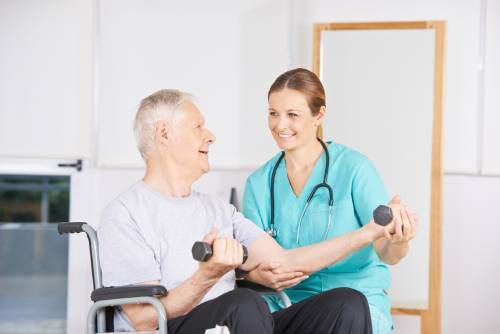Every year, about 795,000 Americans experience a stroke, and thousands of these individuals will experience long-term effects as a result. In fact, stroke is the number one cause of significant and long-term disability in the U.S.
If you've had a stroke, you may feel frustrated by your lack of independence. You may want to do more for yourself in order to ease the strain on your loved ones. Maybe you miss doing the activities and hobbies you used to love. Perhaps you're wondering what you can do to regain more strength in your arms and legs or prevent further problems from developing such as joint contractures or falls. No matter where you are on your stroke rehab journey, there's one thing doctors, researchers, and stroke survivors know for certain:
Physical exercise is an essential—if not the essential—component of your recovery.
In addition, there are many physical therapy devices for stroke recovery that can expedite your healing process.
Common Physical Challenges Faced by a Patient Recovering From Stroke
A stroke, also called a cerebrovascular accident (CVA) or "brain attack," is a type of brain damage caused by an interruption in blood flow and in rare cases from a bleed inside the brain. Strokes range from mild to severe and can be deadly in some cases.
Almost all stroke survivors experience at least some physical effects. These effects - which include motor and sensory impairments - can significantly impair a person's ability to walk, work, or even perform basic self-care activities like washing up, dressing, and getting out of bed.
Common physical effects of stroke include:
- Muscle weakness and paralysis—according to the Stroke Association, 80% of people who have strokes will have motor problems! Usually, muscle weakness (hemiparesis) or total paralysis (hemiplegia) affects one side of the body, opposite to the side of the brain affected by the stroke
- Altered sensation—a person may lose the ability to feel the movement and position of their body (proprioception) or the ability to feel light touch or temperature; again, this usually occurs on one side of the body
- Incoordination
- Fatigue and decreased stamina and endurance
- Pain
- Changes in muscle tone
- Changes in muscle length and joint range of motion
Additionally, many stroke survivors experience problems with vision, spatial awareness, insight, memory, mood, language, decision-making, and impulse control, all of which can make movement much more difficult or even unsafe. To further complicate things, feelings of frustration, sadness, worry, anger, fear, lack of motivation, and even depression are common, and both survivors and their loved ones can endure high levels of stress.
The good news is that exercise may help almost all of these issues! We know exercise can:
- Boost mood and alleviate depression, especially in the post-stroke population
- Improve brain health
- Relieve stress
- Enhance stroke recovery—and even prevent more strokes from happening in the future
Truthfully, no stroke treatment plan would be complete without an exercise program, and the right exercises can make a huge impact on your body, mind, spirit, and quality of life. So, which stroke rehabilitation exercises are best? Let’s check them out!
10 Rehab Exercises for Post Stroke Recovery (Plus a Bonus One!)
The following exercises have been shown to improve strength, range of motion, endurance, balance, and other physical skills after a stroke. They are common in the rehabilitation world and are frequently prescribed by physical and occupational therapists. You can also visit our guide to Physical Therapy for Stroke Recovery at Home in conjunction with this guide on stroke recovery exercises for a complete rehab program at home.
A couple of tips: aim for 10-15 repetitions of each exercise, 2 to 3 times per day, 3 to 5 days per week. Only do the exercises that feel good and safe. If any of the exercises cause pain or make you feel unsafe, either modify them or skip them. You may want to have a loved one or caregiver with you while doing these exercises for added safety. And when in doubt, consult with a professional or ask your doctor about a referral to physical therapy or occupational therapy where you can get more individualized guidance.
1. Wrist Curls
- What it's good for: improving range of motion and strength in the forearm and hand.
- How to do it: hold a lightweight such as a can of beans or a water bottle in your palm. Rest your forearm face up on a table or your lap. Flex your wrist by bringing your palm toward your forearm. You can also work wrist extension by turning your forearm face down and bringing the back of your hand toward your forearm.
- How to modify it: Use your strong hand to apply a gentle stretch at your wrist's end range of motion for 90 seconds in either direction.
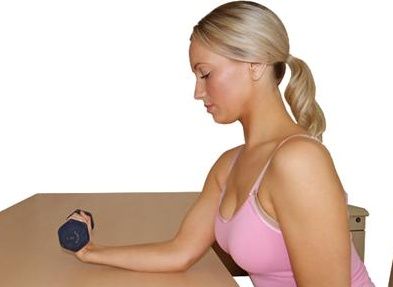
2. Shoulder Openers
- What it's good for: improving strength and range of motion in the shoulder and preventing complications like frozen shoulder or shoulder subluxation.
- How to do it: bend your elbows to 90 degrees and hold them at your sides. Externally rotate your arms like you're opening a door. Think about initiating the movement by squeezing your shoulder blades together.
- How to modify it: add light weights or hold a resistance band with your hands.
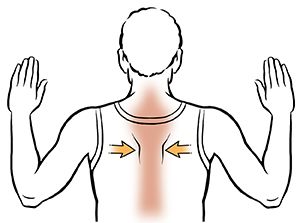
3. Table Circles
- What it's good for: improving strength and coordination in the arms and promoting neuroplasticity (reorganization of nerves and brain cells).
- How to do it: Clasp your hands together and place them on a table in front of you. Using a large “churning” motion, trace a large circle with your hands around the table. Use your strong arm to lead if necessary. Try 10 times clockwise then 10 times counterclockwise.
- How to modify it: To make it harder, hold a handheld dumbbell in your hands. To make it easier, put your hands on a towel to reduce friction.

4. Lateral Trunk Bends
- What it's good for: maximizing core stability and improving balance.
- How to do it: Sit on a comfortable chair or the edge of your bed with your hands on your lap or palm down at your sides. Sit up as tall as you can. Bend your trunk to one side as you reach your arm/hand over your head (and to the same side). Focus on really stretching out the opposite side of your trunk. Hold for a few seconds, then switch to the other side.
- How to modify it: To increase weight-bearing through your weak arm, place your involved hand on a yoga block.
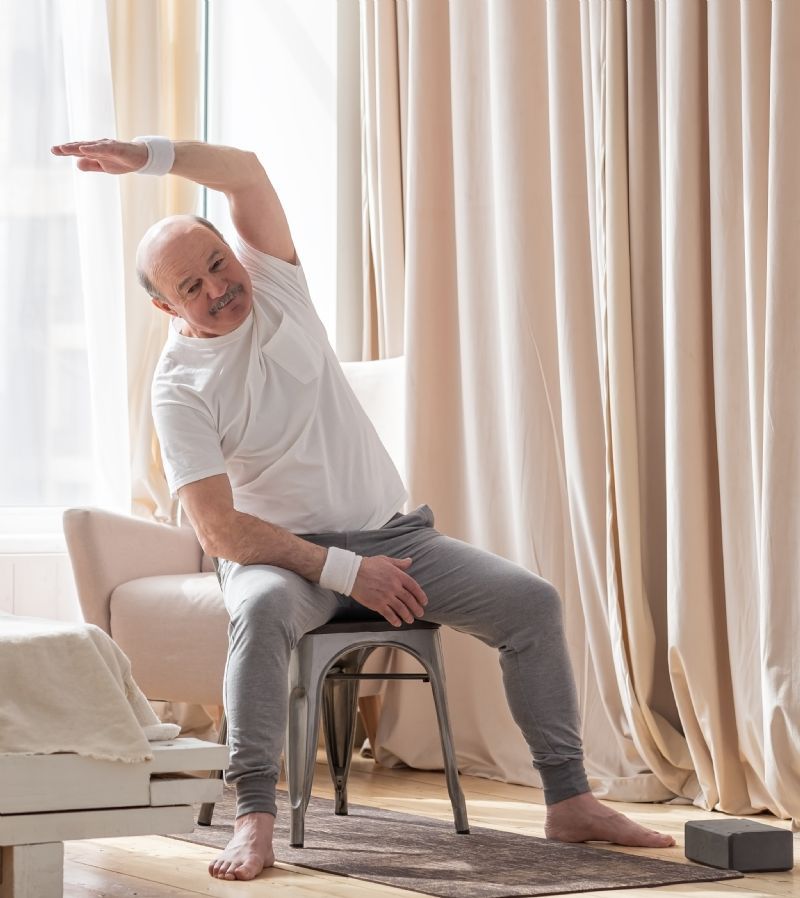
5. Forward Trunk Bends
- What it's good for: to improve core strength and assist with transfers and weight shifting.
- How to do it: sit on a comfortable chair or the edge of your bed with your hands clasped gently on your lap. Bend forward as far as you can go, reaching your hands toward your ankles. Then, using your trunk muscles, sit up all the wall tall.
- How to modify it: Alternate bringing your hands down your left shin and your right shin to practice going out of and returning to the midline.
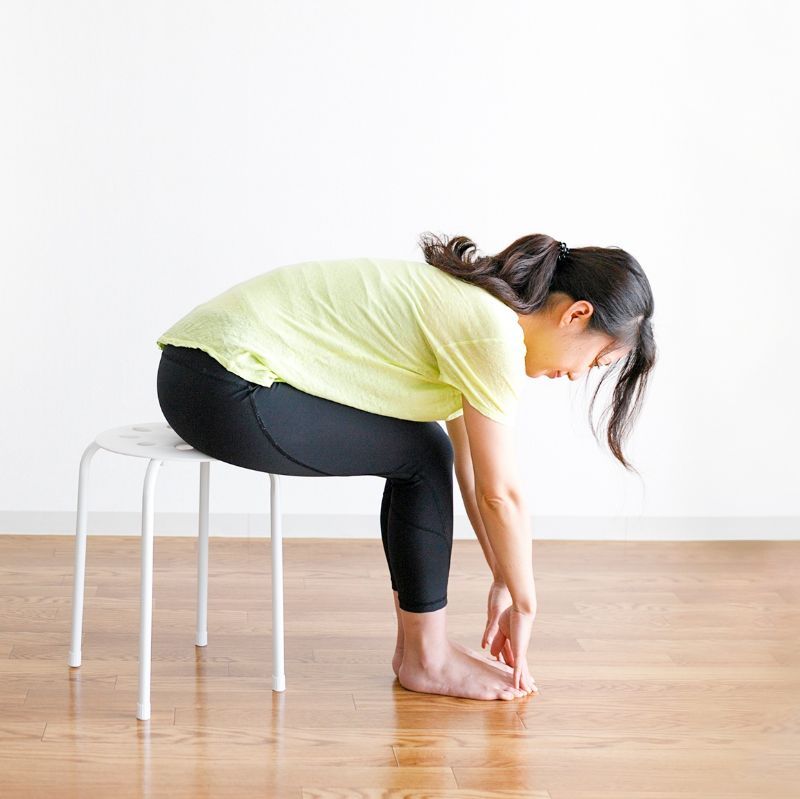
6. Hip Flexion
- What it's good for: strengthening the hip and core, as well as practicing alternating coordination.
- How to do it: sit on a chair or the edge of your bed. Gently tighten your abs and keep your upper body still. Lift one knee as high as it will go. Hold for a count, then lower and switch to the other side. This exercise is called a “seated knee raise”.
- How to modify it: you can advance this by doing it standing up while holding on to a counter or sturdy table for support. Or, you can try it lying on your back and bringing your knee towards your chest.
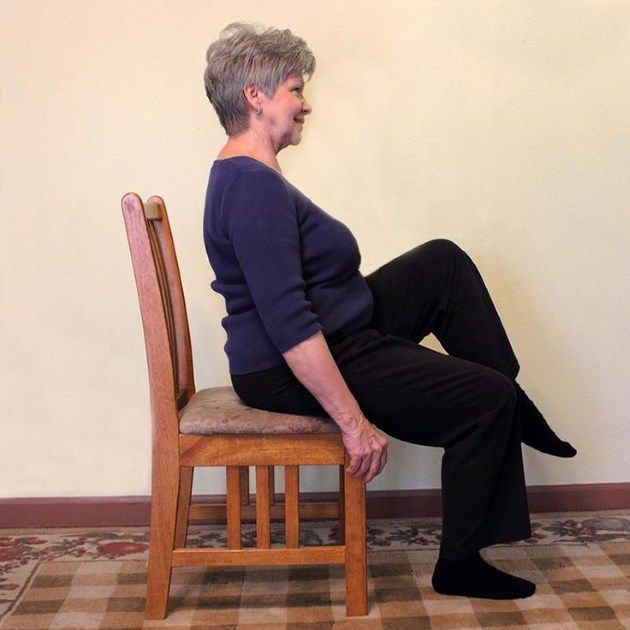
7. Hip Abduction
- What it's good for: strengthening your leg and core muscles, as well as improving
- pelvic stability.
- How to do it: sit on a chair or the edge of your bed. Gently tighten your abs and keep your upper body still. Straighten one knee, then kick your foot out to the side. Try to keep the toe pointed forward (don’t let it turn out). Return to the start position, then repeat on the other side.
- How to modify it: advance this by doing it in standing, or make it easier by doing it while lying on your back.
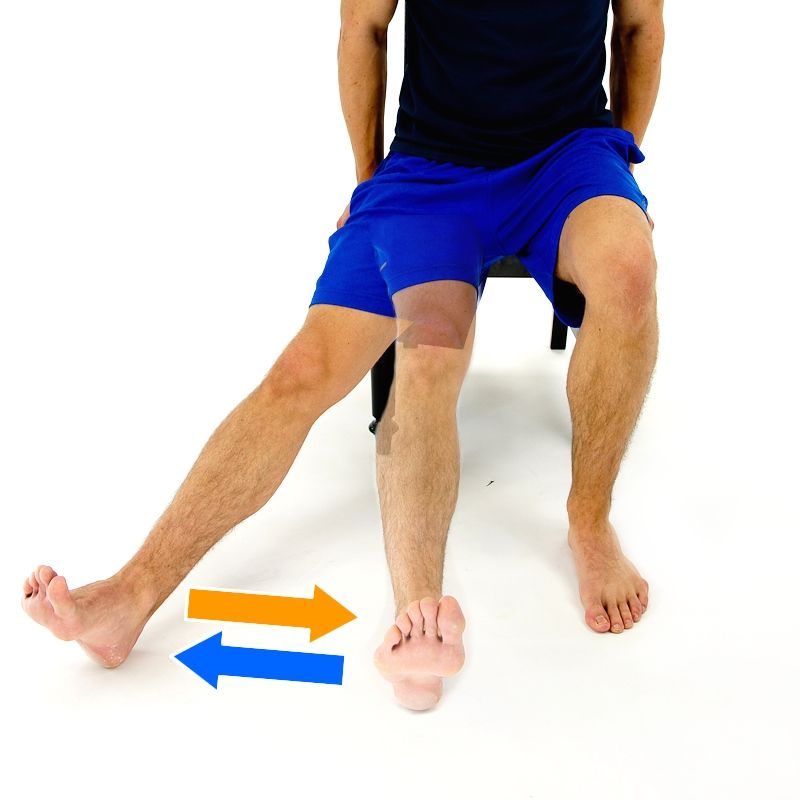
8. Sit to Stand
- What it's good for: strengthening your core and legs, improving your weight shifting and balance.
- How to do it: sit on a chair or the edge of the bed with your feet flat on the floor about hip-width apart. Your knees should be bent and your feet should be directly under your knees. Lean forward (think “nose over toes”) like you are taking off like an airplane but not a rocket ship; slowly stand up all the way. You can use your arms to help. Then, slowly sit back down.
- How to modify it: there are so many ways to make this harder or easier to meet your needs! You can try: not using your hands, lowering in slow motion to the count of 3, holding a light dumbbell in your hands, or even putting your uninvolved foot on a low stool to “force” your weaker leg to work harder.
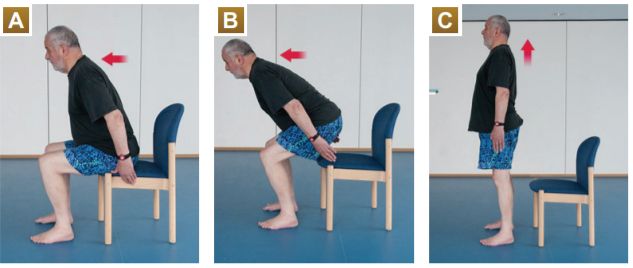
9. Bird Dog
- What it's good for: excellent for core strength and facilitating helpful weight-bearing through both your arms and legs (great for improving sensation).
- How to do it: get into a tabletop position with your hands under your shoulders and knees under your hips. Keep your neck in line with the rest of your spine by maintaining a gentle gaze straight ahead (don’t drop your head down nor lift it up too high). Gently contract your abs. Extend one arm straight in front of you while extending the opposite leg straight behind you. Pretend there is a glass of water on your lower back and try not to spill it. Hold for a count, then return to the start position and try on the opposite side.
- How to modify it: if lifting one arm and one leg at the same time is too challenging, lift one limb at a time. You can also keep all four limbs planted and gently rock forward and back or side to side.
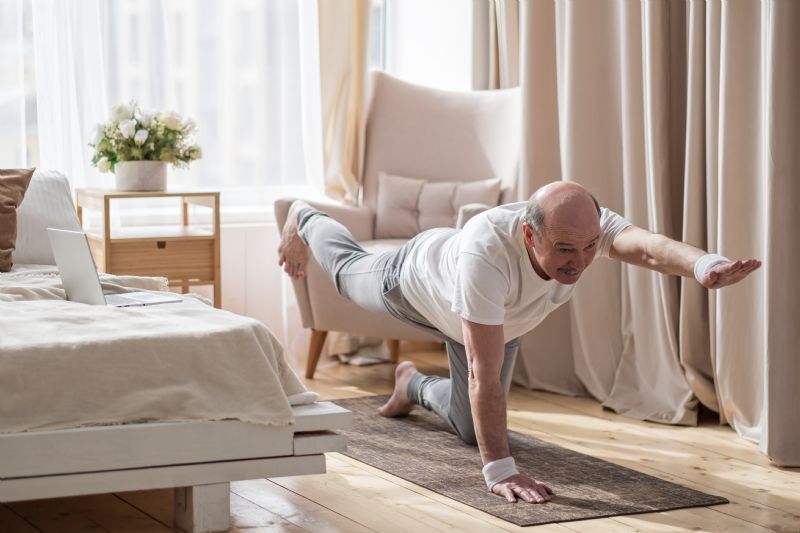
10. Supine Bridge
- What it's good for: boosting strength in your core and posterior chain, especially in the glutes which is essential for standing and transferring.
- How to do it: lie on your back with your feet flat on the ground, knees up, arms relaxed by your sides, and palms down (try a yoga mat for comfort). Gently contract your abs. Press through your heels and lift your buttocks into the air. Hold at the top for one count, then slowly lower.
- How to modify it: make this easier by straightening your legs and placing a large bolster under your knees, then lifting your hips up by pressing against the bolster. Make it harder by lifting and lowering one foot, then the other, while holding the top of the bridge.
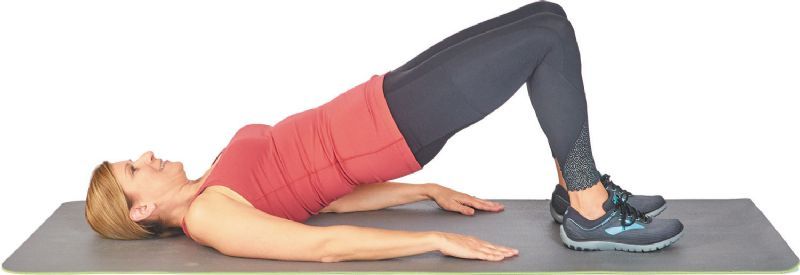
Bonus Exercise: Aerobic Conditioning!
Aerobic exercises such as treadmill walking and recumbent cycling can boost stroke survivors' overall health, improve sensory and motor skills, and prevent recurring strokes. The American Heart Association recommends 2.5 hours of heart-pumping physical activity every week.
The key is to find something you enjoy and that helps you address your specific needs and goals.
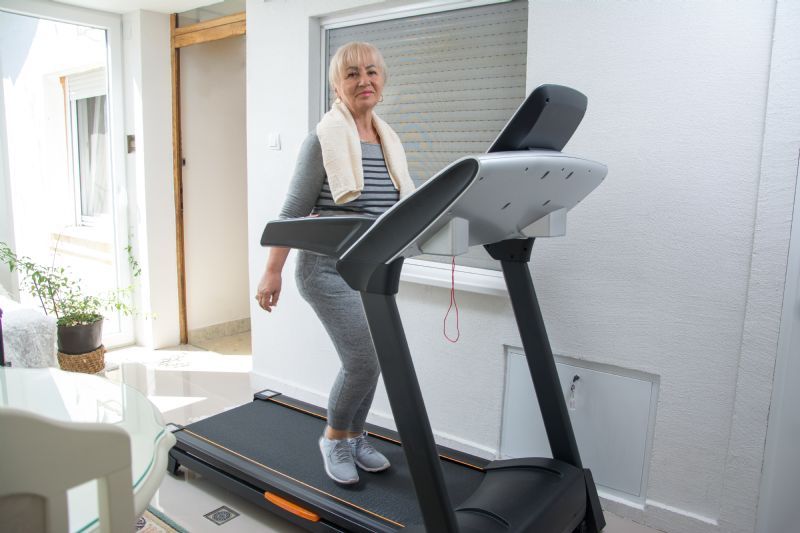
A Word on BE FAST
A stroke can be life-changing, but identifying the warning signs of a stroke as soon as possible is critical to getting early medical help and mitigating damage. That's why it's important for you, your loved ones, and your patients to know what it means to BE FAST. Research shows the following updated mnemonic is more effective—compared to the original "FAST" version—at helping people identify early warning signs and symptoms of stroke:
- Balance: sudden problems with balance, coordination, and walking, and/or complaints of dizziness
- Eyes: sudden changes in vision or complaints of a headache
- Face: sudden droopiness on one side of the face
- Arms: sudden weakness, numbness, and/or tingling in arm or leg
- Speech: sudden slurred speech, other speech difficulties, and/or confusion
- Time: if you or someone you know experiences any of the above signs or symptoms, call 911 immediately!
If you work in physiotherapy or another field of healthcare, you need to educate your patients and their loved ones about this helpful reminder. And with a growing older population and rise in chronic illness, it's never been more essential to raise stroke awareness no matter what your profession is.
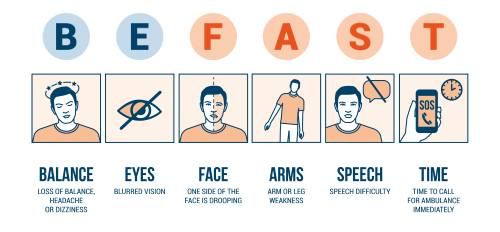
Click here to view and print the full chart
Final Thoughts
Every 45 seconds, someone in America experiences a stroke. With so many people affected by this condition, it's important to know the warning signs of stroke as well as the best exercises that can help you or your loved one heal from the physical effects and improve your quality of life.
Everyone, including stroke survivors, should aim to do physical exercise most days of the week. This includes:
- Light to moderate aerobic exercise: 20 to 60 minutes, 3 to 7 days per week, and
- Resistance exercises: 2 to 3 sets of 10 to 15 repetitions per set, 3 to 5 days per week.
Explore all physical therapy devices for stroke recovery for sale. Be sure to check out our favorite brand, Saebo, for innovative stroke recovery products.
For movement tips, modifications, progressions, and other helpful information, chat with a physical therapist or other health professional.
Want to learn more about strokes? Check out our Stroke Recovery articles that cover stroke product reviews, buying guides, and helpful tips. And if you are interested in other topics like wheelchairs, aging in place, fall prevention, and more - visit our primary blog Caregiver University.
Author:
Benjamin K. Mattox, DrPH, PA-C
Orthopedic surgery physician assistant, doctor of public health, and owner of a public health consulting firm. With over a decade of Active Duty Navy Experience, Deployments with the Navy SEALS, and as a Professor for Purdue University - Dr. Mattox is a highly qualified and experienced clinician with a firm understanding of orthotic needs, rehabilitation, home access needs, gait therapy, and veteran-specific health needs.
Meet all of our experts here!
 Written by Benjamin K. Mattox, DrPH, PA-C
Written by Benjamin K. Mattox, DrPH, PA-C
